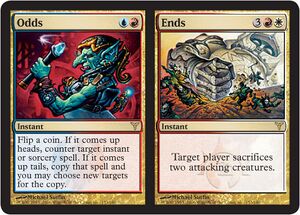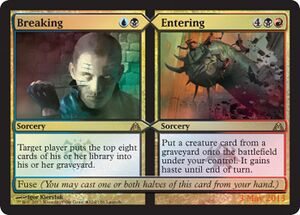Split card: Difference between revisions
>Yandere-sliver (clean up, replaced: {{TumblrRef|author=Mark Rosewater|URL= → {{EzTumblr|url= (4), |tumblr-title=Blogatog| → | (4)) |
>Yandere-sliver m (clean up, replaced: {{EzTumblr|url= → {{EzTumblr| (4), |date= → | (4)) |
||
| Line 1: | Line 1: | ||
[[File:Odds and Ends.jpg|thumb|right|Split card: Odds and Ends]] | [[File:Odds and Ends.jpg|thumb|right|Split card: Odds and Ends]] | ||
'''Split cards''' are ''[[Magic]]'' [[card]]s with two card faces on the front side. A split card is literally "split" into two separate cards each with its own card name, art, [[Mana|mana cost]], text, etc. Split cards can only be [[instant]]s and [[sorceries]], not [[permanent]]s.<ref>{{EzTumblr| | '''Split cards''' are ''[[Magic]]'' [[card]]s with two card faces on the front side. A split card is literally "split" into two separate cards each with its own card name, art, [[Mana|mana cost]], text, etc. Split cards can only be [[instant]]s and [[sorceries]], not [[permanent]]s.<ref>{{EzTumblr|http://markrosewater.tumblr.com/post/178934945123/could-a-split-card-feature-a-creaturecreatures|title=Could a split card feature a creature/creatures?|October 10, 2018}}</ref> | ||
==Description== | ==Description== | ||
| Line 6: | Line 6: | ||
In any zone except [[the stack]], a split card has the combination of both characteristics; while it's on the stack, it only has the characteristics of the half being played. This provides many interesting interactions with cards that create effects based on converted mana cost. For example, if <c>Dark Confidant</c> reveals a split card, you would lose life equal to the total converted mana cost of both sides. | In any zone except [[the stack]], a split card has the combination of both characteristics; while it's on the stack, it only has the characteristics of the half being played. This provides many interesting interactions with cards that create effects based on converted mana cost. For example, if <c>Dark Confidant</c> reveals a split card, you would lose life equal to the total converted mana cost of both sides. | ||
Split cards are considered to be [[deciduous]].<ref>{{EzTumblr| | Split cards are considered to be [[deciduous]].<ref>{{EzTumblr|http://markrosewater.tumblr.com/post/162425409498/just-listened-to-the-hybrid-mana-episode-of-drive|title=What mechanics and tools are currently considered Deciduous?|June 30, 2017}}</ref> | ||
==History== | ==History== | ||
| Line 18: | Line 18: | ||
===Naming convention=== | ===Naming convention=== | ||
Regular split cards are named with a ”__________ and __________“ convention while Aftermath cards use a ”__________ to __________“ convention.<ref>{{EzTumblr| | Regular split cards are named with a ”__________ and __________“ convention while Aftermath cards use a ”__________ to __________“ convention.<ref>{{EzTumblr|http://markrosewater.tumblr.com/post/159174592333/is-the-naming-convention-for-the-new-aftermath|title=Is the naming convention for the new aftermath cards still and (Fire and Ice) or has it changed?|April 03, 2017}}</ref><ref>{{EzTumblr|http://markrosewater.tumblr.com/post/177984504623/how-do-you-say-the-new-split-cards-names-there|title=How do you say the new Split cards names?|September 11, 2018}}</ref> In ''[[Guilds of Ravnica]]'', the card halves have alliterative names, starting with the same three letters. | ||
==Rules== | ==Rules== | ||
Revision as of 23:57, 31 March 2019

Split cards are Magic cards with two card faces on the front side. A split card is literally "split" into two separate cards each with its own card name, art, mana cost, text, etc. Split cards can only be instants and sorceries, not permanents.[1]
Description

In any zone except the stack, a split card has the combination of both characteristics; while it's on the stack, it only has the characteristics of the half being played. This provides many interesting interactions with cards that create effects based on converted mana cost. For example, if Dark Confidant reveals a split card, you would lose life equal to the total converted mana cost of both sides.
Split cards are considered to be deciduous.[2]
History
Split cards were introduced in the Invasion block, where each half was from a different color.[3] In Dissension each half was a multicolored card from a different guild.[4][5] Planar Chaos had split cards were introduced where both halves were the same color (all split cards in PC are red).
After the introduction of split cards, Unhinged featured Who/What/When/Where/Why which resembled a split card with five different effects.
Dragon's Maze introduced split cards with Fuse, an ability that lets you play both halves as one spell.[6] Amonkhet added split cards with Aftermath, an ability that lets you play the 'bottom' part from the graveyard.[7][8] Split cards with aftermath have a new frame treatment — the half you can cast from your hand is oriented the same as other cards you'd cast from your hand, while the half you can cast from your graveyard is a traditional split card half. This frame treatment is for your convenience and has no rules significance.
Split cards returned again in Guilds of Ravnica. Each one focuses on a single guild, with a smallish hybrid mana effect as one half and a bigger, multicolor mana effect as the other.[9][10][11] The art of the rares focuses on the two major characters (legendary creatures or planeswalkers) in that guild, one personality per side.
Naming convention
Regular split cards are named with a ”__________ and __________“ convention while Aftermath cards use a ”__________ to __________“ convention.[12][13] In Guilds of Ravnica, the card halves have alliterative names, starting with the same three letters.
Rules

Rulings
- With Amonkhet, the converted mana cost (CMC) of split cards were simplified.[14] The CMC of a split card is always the combination of both halves except on the stack. On the stack, only the half which is actually cast is considered for color and CMC. Formerly, a split card would have two separate costs and a total converted mana cost of the sum of those two separate costs. This would allow for interactions such as Isochron Scepter and Fire // Ice for repeatable direct damage or card draw.
Notable split cards
- Fire // Ice - Legacy threshold decks
- Research // Development - Vintage decks
See also
References
- ↑ Mark Rosewater (October 10, 2018). "Could a split card feature a creature/creatures?". Blogatog. Tumblr.
- ↑ Mark Rosewater (June 30, 2017). "What mechanics and tools are currently considered Deciduous?". Blogatog. Tumblr.
- ↑ Template:NewRef
- ↑ Template:NewRef
- ↑ Template:NewRef
- ↑ Template:NewRef
- ↑ Template:NewRef
- ↑ Template:NewRef
- ↑ Doug Beyer on Twitter
- ↑ Template:NewRef
- ↑ Template:NewRef
- ↑ Mark Rosewater (April 03, 2017). "Is the naming convention for the new aftermath cards still and (Fire and Ice) or has it changed?". Blogatog. Tumblr.
- ↑ Mark Rosewater (September 11, 2018). "How do you say the new Split cards names?". Blogatog. Tumblr.
- ↑ Template:NewRef